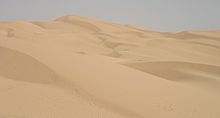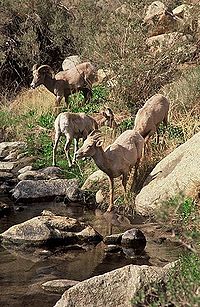- Colorado Desert
-
California's Colorado Desert is a part of the larger Sonoran Desert, which extends across southwest North America. The Colorado Desert region encompasses approximately 7 million acres (2,800,000 ha), reaching from the Mexican border in the south to the higher-elevation Mojave Desert in the north and from the Colorado River in the east to the Laguna Mountains of the Peninsular Ranges in the west. The area includes the heavily irrigated Coachella and Imperial Valleys. The Colorado Desert is home to many unique flora and fauna, many of which can be found nowhere else on the planet.
Contents
Geography and geology
The Colorado Desert region encompasses approximately 7 million acres (28,000 km2), reaching from the Mexican border in the south to the higher-elevation Mojave Desert in the north and from the Colorado River in the east to the Laguna Mountains of the Peninsular Ranges in the west. The desert encompasses Imperial County and includes parts of San Diego County, Riverside County, and a very small part of San Bernardino County.[1]
The majority of the Colorado Desert lies at a relatively low elevation, below 1,000 feet (300 m), with the lowest point of the desert floor at 275 feet (84 m) below sea level at the Salton Sea. Although the highest peaks of the Peninsular Range reach elevations of nearly 10,000 feet (3,000 m), most of the region's mountains do not exceed 3,000 feet (910 m).
In this region, the geology is dominated by the transition of the tectonic plate boundary from rift to fault. The southernmost strands of the San Andreas Fault connect to the northern-most extensions of the East Pacific Rise. Consequently, the region is subject to earthquakes, and the crust is being stretched, resulting in a sinking of the terrain over time.
Climate
The Colorado Desert's climate distinguishes it from other deserts. The region experiences greater summer daytime temperatures than higher-elevation deserts and almost never experiences frost. In addition, the Colorado Desert experiences two rainy seasons per year (in the winter and late summer), especially toward the southern portion of the region; the more northerly Mojave Desert has only winter rains.[1]
The west coast Peninsular Ranges, or other west ranges, of Southern California–northern Baja California, block most eastern Pacific coastal air and rains, producing an arid climate.[1] Other short or longer-term weather events can move in from the Gulf of California to the south, and are often active in the summer monsoons. These include remnants of Pacific hurricanes, storms from the southern tropical jetstream, and the northern ITCZ.
Flora and fauna
See also categories: Fauna of the Sonoran Desert and Fauna of the Sonoran Desert.The region's terrestrial habitats include creosote bush scrub; mixed scrub, including yucca and cholla cactus; desert saltbush; sandy soil grasslands; and desert dunes. Higher elevations are dominated by pinyon pine and California juniper, with areas of manzanita and Coulter pine. In addition to hardy perennials, more than half of the desert's plant species are herbaceous annuals, and appropriately timed winter rains produce abundant early spring wildflowers. In the southern portion of the region, the additional moisture supplied by summer rainfall fosters the germination of summer annual plants and supports smoketree, ironwood, and palo verde trees. The unique Joshua Tree can be found in Joshua Tree National Park,[1] as well as small regions of central or northwestern Arizona.
Common desert wildlife include mule deer, bobcat, desert kangaroo rat, cactus mouse, black-tailed jackrabbit, Gambel's quail, and red-diamond rattlesnake. Among sensitive species are flat-tailed horned lizard, Coachella Valley fringe-toed lizard, desert tortoise, prairie falcon, Andrews' dune scarab beetle, Peninsular bighorn sheep, and California leaf-nosed bat.[1]
In the Colorado Desert's arid environment, aquatic and wetland habitats are limited in extent but are critically important to wildlife. Runoff from seasonal rains and groundwater springs forms desert arroyos, desert fan palm oases, freshwater marshes, brine lakes, desert washes, ephemeral and perennial streams, and riparian vegetation communities dominated by cottonwood, willow, and non-native tamarisk. Two of the region's most significant aquatic systems are the Salton Sea and the Colorado River. While most desert wildlife depend on aquatic habitats as water sources, a number of species, such as arroyo toad, desert pupfish, Yuma clapper rail, and southwestern willow flycatcher[disambiguation needed
 ], are restricted to these habitats. In some places, summer rains produce short-lived seasonal pools that host uncommon species like Couch's spadefoot toad.
], are restricted to these habitats. In some places, summer rains produce short-lived seasonal pools that host uncommon species like Couch's spadefoot toad.Desert fan palm oases are rare ecological communities found only in the Colorado Desert. They occur only where permanent water sources are available, such as at springs or along fault lines, where groundwater is forced to the surface by the movement of hard impermeable rock, and can be found in the San Jacinto, Santa Rosa, and Little San Bernardino mountains, in the canyons of Anza-Borrego Desert State Park, and along the San Andreas Fault in the Coachella Valley.[1] The only palm native to California, Washingtonia filifera (desert fan palm), grow at the oases.[2]
Endemic flora
Some sub-regions of the Colorado Desert contain endemic flora. Along the Lower Colorado River Valley, in-flow side canyons, flatlands, or low to higher level elevations, at least three endemic flora exist: Hesperocallis undulata (desert lily), Nolina bigelovii (Bigelow's nolina), and Peucephyllum schottii (desert fir).
National and State Parks
- Joshua Tree National Park
- Imperial NWR
- Sonny Bono Salton Sea NWR
- Indio Hills Palms
- Anza-Borrego Desert State Park
- Ocotillo Wells State Vehicular Recreation Area
- Picacho State Recreation Area
- Heber Dunes State Vehicular Recreation Area
- Salton Sea State Recreation Area
Environmental issues
Although the Colorado Desert remains one of the least-populous regions in California, human activities have had substantial impacts on the region's habitats and wildlife. Many unique communities, particularly aquatic and dune systems, are limited in distribution and separated by vast expanses of inhospitable, arid desert terrain. Even limited human disturbances can have markedly deleterious effects on the endemic and sensitive species supported by these unique regional systems.[1]
Some of the greatest human-caused effects on the region have resulted from the water diversions and flood control measures along the Colorado River. These measures have dramatically altered the region's hydrology by redistributing the region's water supply to large expanses of irrigated agriculture and metropolitan coastal areas such as Los Angeles and San Diego. The once-dynamic Salton Sea and Colorado River ecosystems are now controlled by human water management. Because of the scarcity of water resources in the desert environment, these alterations have had substantial impacts on regional wildlife and habitats. In addition, portions of the region are experiencing substantial growth and development pressures, most notably the Coachella Valley.[1]
See also
References
- ^ a b c d e f g h "Colorado Desert". http://www.dfg.ca.gov/wildlife/WAP/region-colorado.html. Retrieved 2009-08-06.
- ^ "A Desert Park". National Park Service. http://www.nps.gov/jotr/planyourvisit/desertpark.htm. Retrieved 2009-05-06.
External links
Colorado Desert Region Counties Imperial County · San Diego County(part) · Riverside County(part) · San Bernardino County(part)
Major Cities El Centro · Palm Springs · Indio · Palm Desert · Coachella · Calexico · Brawley · Blythe ·
Natural features Sonoran Desert · Colorado Desert · Imperial Valley · New River · Coyote Mountains · Chocolate Mountains · Algodones Dunes · Colorado River · Salton Sea · San Andreas Fault · Fossil Canyon · Painted Gorge
Historical interests Designated areas Joshua Tree National Park · Imperial National Wildlife Refuge · Heber Dunes · Ocotillo Wells · Picacho · Salton Sea State Recreation Area · Indio Hills Palms · Sonny Bono Salton Sea National Wildlife Refuge · Anza-Borrego Desert State Park
World deserts Africa Asia - Ad-Dahna
- Arabian
- Aral Karakum
- Aralkum
- Badain Jaran
- Betpak-Dala
- Cholistan
- Dasht-e Kavir
- Dasht-e Lut
- Dasht-e Margoh
- Dasht-e Naomid
- Gurbantünggüt
- Gobi
- Hami
- Indus Valley
- Judean
- Karakum
- Kharan
- Kumtag
- Kyzyl Kum
- Lop
- Nefud
- Negev
- Ordos
- Qaidam
- Rub' al Khali
- Russian Arctic
- Registan
- Saryesik-Atyrau
- Syrian
- Taklamakan
- Tengger
- Thal
- Thar
- Tihamah
- Ustyurt Plateau
- Wahiba Sands
- Liwa
Europe North America - Alvord
- Amargosa
- Baja California
- Black Rock
- Carcross
- Channeled scablands
- Chihuahuan
- Escalante
- Forty Mile
- Gran Desierto de Altar
- Great Basin
- Great Salt Lake
- Great Sandy
- Jornada del Muerto
- Kaʻū
- Lechuguilla
- Mojave
- North American Arctic
- Owyhee
- Painted Desert
- Red Desert
- Sevier
- Smoke Creek
- Sonoran
- Tule (Arizona)
- Tule (Nevada)
- Yp
- Yuha
- Yuma
Australia South America Polar regions New Zealand Categories:- Colorado Desert
- Deserts and xeric shrublands in the United States
- Ecoregions of the United States
- Sonoran Desert
- Deserts of California
- Deserts of the Lower Colorado River Valley
- Geologic provinces of California
- Geography of Riverside County, California
- Geography of San Bernardino County, California
- Coachella Valley
- Imperial Valley
Wikimedia Foundation. 2010.



